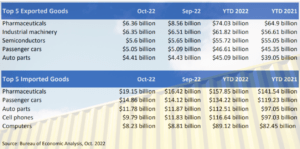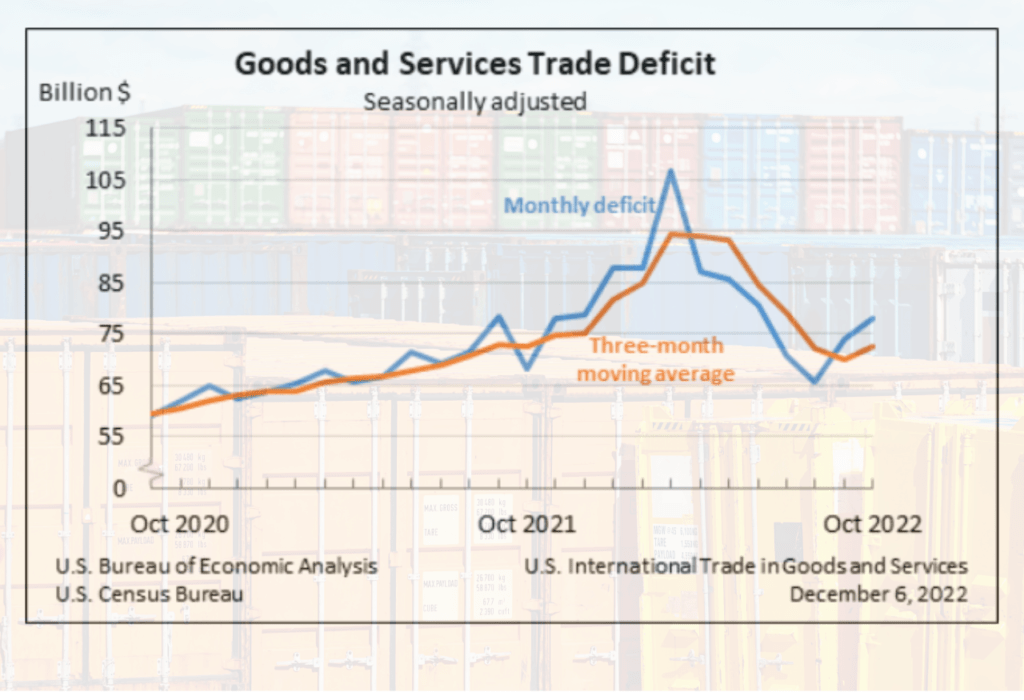Another record-breaking year for the goods deficit is upon us.
The October trade deficit increased from $74.1 billion in September (revised) to $78.2 billion in October, the Bureau of Economic Analysis said on Tuesday. The goods deficit increased $6.1 billion in October to $99.6 billion for the month, its highest monthly level since May when the goods deficit was over $104.3 billion.
Year-to-date, the goods and services deficit is up by $136.9 billion, or 19.9%, from the same period in 2021. Exports increased $415.3 billion or 19.8% so far, which actually matched the percentage increase in imports. Imports rose $552.2 billion from this time last year.
All told, the goods deficit for the year so far is $1.02 trillion. With two months left, if the U.S. posts even a modest $70 billion trade deficit in November and October, the goods trade gap with the world will easily breach $1.1 trillion, another record. Last year’s goods deficit was $1.02 trillion, spurred along by government stimulus and pandemic restrictions that diverted spending away from services and towards purchases of manufactured consumer goods.
This year’s goods trade deficit will likely approach the $1.2 trillion mark.
An overvalued currency is a significant driver of the recent import surge and the decline in U.S. exports. The dollar index has risen by around 10% this year, with even larger increases against key competitor currencies like the Japanese yen and Chinese renminbi. This makes U.S. goods more expensive on world markets. And it makes importing cheaper as the dollar goes further abroad than it does at home.
“With a trade deficit worth more than 4% of GDP and the dollar up by double-digit percentages against most other major currencies, now is the time for the Biden administration to take action to stimulate domestic supply and domestic demand with action to reduce the deficit and drive the dollar to competitive levels,” said CPA Chief Economist Jeff Ferry.
“Furthermore, our goods deficit so far this year with the European Union is $165 billion and European leaders are asking that we modify the Inflation Reduction Act to help out their automakers. That should be ignored. The U.S. is already providing far too much stimulus to the European economy,” Ferry said.
The October figures show the five biggest monthly deficits were with China ($26.1b), European Union ($23.1b), Mexico ($11.6b) Vietnam ($9.4b), and Germany ($8.1b). These countries remain unchanged throughout the year, with Vietnam growing as an outsource hub for both Chinese and American manufacturers.
- The goods deficit with the European Union increased $7.1 billion to $23.1 billion in October. Exports decreased $1.2 billion to $28.8 billion and imports increased $5.9 billion to $51.9 billion.
- The goods deficit with China decreased $6 billion to $26.1 billion in October. Exports increased $1.4 billion to $13.6 billion and imports decreased $4.6 billion to $39.7 billion, though a lot of this could be due to China lockdowns due to Covid restrictions disrupting deliveries.
Our top manufactured goods — whether imported or exported — remain relatively stable month over month in terms of market sectors. Pharmaceuticals and autos continue to lead the way. All told, the U.S. remains a massive commodities exporter, led by fossil fuel exports and agriculture. Still, within the top exported goods, pharmaceuticals and industrial equipment remain a major part of U.S. trade flow, making them key sectors to help reduce America’s trade gap with the world.














